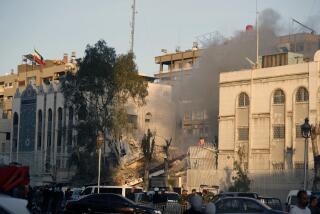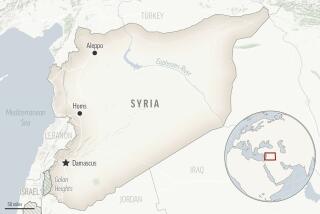Syria defectors shed light on regime’s crackdown
Days before Syrian forces launched a deadly offensive against street protesters in the western city of Baniyas, the colonel leading the attack gathered up six of his officers. The colonel, one of the officers later recounted, put his cellphone on the loudspeaker setting, for all to hear.
The voice of Syria’s then-defense minister, Ali Habib, boomed out, providing chilling orders for a crackdown on Baniyas’ civilian protesters:
“Any kind of gathering, you disperse it with sheer force. You shoot,” the minister said that day in May, recalled a 21-year-old lieutenant in the quwat-al-khassat, or special forces, who said he was one of the six gathered around the colonel’s phone.
“And the officer who cannot handle that and disagrees, we will deal with them directly.”
The Los Angeles Times spoke to three Syrian military men, all members of the nation’s Sunni Muslim majority, who, reached independently, said they fled between May and August to avoid being forced to shoot unarmed civilians, or being shot themselves for refusing.
A fourth Syrian interviewed by The Times identified himself and was identified by one of the other defectors as a first lieutenant in the military intelligence service, or mukhabarat.
Together, their accounts offer insight about the planning and organization behind the deadly offensive that activists, rights groups and Western governments allege Syrian President Bashar Assad’s regime has unleashed against predominantly peaceful street demonstrations by citizens demanding governmental change.
The four all said orders to shoot protesters came from top officials and were explicit. Officials of the United Nations and Human Rights Watch say actions of that sort may constitute crimes against humanity.
The men also said that Assad’s forces have been augmented in their attacks by Revolutionary Guard forces from Iran and by members of the shabiha, the Syrian civilian militia composed of otherwise unemployed and underemployed men whom the government is said to pay by the day for missions that include shooting at civilians.
Three of the interviews were conducted in person or on the phone in neighboring Lebanon. The fourth, with a man who said he was living in a Syrian town bordering Turkey, was conducted by Skype.
The three Syrian army men — a captain, a lieutenant and a sergeant — produced the same type of salmon-colored military ID cards. The cards displayed their names and photos in uniform, under the emblem “Syrian Arab Republic, General Leadership of the Armed Forces, Administration of Officer Affairs.” The sources asked that their names be withheld because they feared retribution.
The sergeant said his last hours of service in the Syrian armed forces came one day in early June, when he and others under the command of a high-ranking Defense Ministry official were sent to the northern town of Jisr Shughur to crush an uprising.
“The town was empty,” recounted the sergeant. “We heard the distant voice of a muezzin’s call to prayer, and then the chanting of a protest.”
“We were ordered to shoot in that direction, without knowing who, and where, we were shooting.” Fellow soldiers, he said, “started shooting.”
Unwilling to fire on unarmed people, he said he fell back with another soldier, who was from the town and knew the backstreets. Soon, he said, they dropped their guns and were fleeing down narrow lanes past the corpses of civilians, some of them children, in the streets and on doorsteps.
“Usually, there is a whole line of security forces behind our backs” to shoot soldiers who refuse to fire on protesters, the sergeant recounted. “I was lucky to be able to run away.”
“When you reach a point where you have to shoot at civilians, when a bullet has to come out of your gun and hit a civilian, then you’ll understand how easy a decision it was to run away,” he said.
Many other soldiers “share my opinions but are afraid of putting their families at risk,” he said. “We are a police state.”
All three military men described the planning with which Assad’s government allegedly cracked down on civilian protesters.
In Baniyas, where the 21-year-old special forces lieutenant said he was deployed, he and other soldiers and intelligence service agents were brought in from other towns in late April and early May. Authorities routinely juggled deployments, calculating that soldiers would be more willing to fire on strangers than neighbors, the three who fled said.
At Baniyas, officers were briefed on a detailed plan of attack about four days in advance, the lieutenant said, including the use of artillery and tanks. Military officials also ordered the detention of all men between the ages of 18 and 45 found on the streets, the lieutenant said.
The first targets: mosques, where opposition activists gather for rallies, and hospitals, where wounded protesters go for treatment.
“People could not imagine they would be targeted in mosques, in hospitals,” said the young lieutenant, now in hiding in Lebanon. The government “wanted to end their sense that there was any shelter, anywhere.”
On one of the final days before the Baniyas operation, the lieutenant said, more than a dozen vehicles carrying Iranian Revolutionary Guard troops arrived. Like members of the Syrian mukhabarat, the Iranians wore Syrian army uniforms, he said. But the Iranians kept to themselves, speaking to one another in a language that few of the Syrians could follow.
U.S. and European officials have charged that Iran’s Revolutionary Guard is aiding the Syrian crackdown. The European Union has leveled sanctions against Iranian officials and specific Revolutionary Guard units for the alleged support, which Iran denies.
The lieutenant said he was accustomed to seeing Revolutionary Guard troops in Syria, but usually for joint training, and never so many at once.
“For the Iranians, these are not their people,” the lieutenant said, referring to the Syrian protesters targeted. “It’s easier for them to do the job.”
Even before the crackdown, Syrian soldiers knew of the Revolutionary Guard’s presence by their marksmanship, said the alleged defector from Syria’s military intelligence, a first lieutenant in his late 40s.
The mukhabarat lieutenant said that in Homs, a western city that has experienced some of the most unrelenting protests in the six-month uprising and the harshest crackdowns, one of his duties was taking Iranian marksmen to the rooftops of strategic government buildings and other high vantage points — the municipal electricity building, the post office and a hotel — where they would have a wide view of the protesters.
State news reports describe the violence as attacks by armed extremists on the country’s military.
But another crucial component of the Syrian crackdown is the shabiha, civilians armed with guns and clubs.
The defectors describe the plainclothes shabiha as among the most remorseless government enforcers. Those who are employed are often poorly paid street cleaners, moonlighting to supplement their income, according to the Syrian captain.
“Every day they get $20 to $30,” said the 30-year-old captain, who is now living in Lebanon near the Syrian border. “The pay depends on how good of a shape they’re in.”
A single motive has led many members of the shabiha to beat and shoot fellow Syrians, the captain said: “Money.”
“It’s their job,” he said. “They don’t have any other work.”
He said he watched at protests as mukhabarat stationed shabiha around a square, or around mosques, to fire on worshipers trying to leave after prayers.
At this point, the captain said, both government and opposition forces feel they are waging a life-or-death struggle, that they will be killed by the other side if they capitulate.
The activists “know that if they stop now, they are finished,” said the officer, his hair still military-short, as he spoke in a front parlor with a window opening onto the mountains of Syria. “And Assad will fight to the last drop of blood from a Syrian.”
Knickmeyer is a special correspondent. Special correspondent Roula Hajjar in Beirut contributed to this report.
More to Read
Start your day right
Sign up for Essential California for news, features and recommendations from the L.A. Times and beyond in your inbox six days a week.
You may occasionally receive promotional content from the Los Angeles Times.






